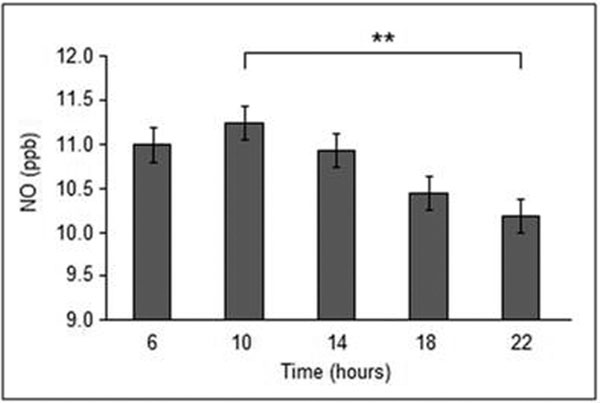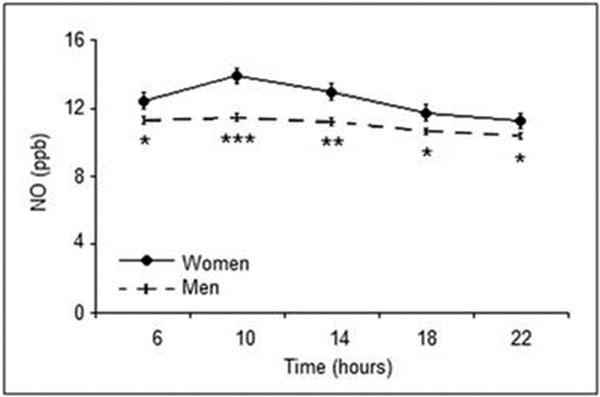Abstract
Objective
Exhaled nitric oxide (eNO) has been suggested as a marker of airway inflammatory diseases. The level of eNO is influenced by many various factor including age, sex, menstrual cycle, exercise, food, drugs, etc. The aim of our study was to investigate a potential influence of circadian variation on eNO level in healthy subjects.
Methods
Measurements were performed in 44 women and 10 men, non-smokers, without respiratory tract infection in last 2 weeks. The eNO was detected at 4-hour intervals from 6 a.m. to 10 p.m. using an NIOX analyzer. We followed the ATS/ERS guidelines for eNO measurement and analysis.
Results
Peak of eNO levels were observed at 10 a.m. (11.1 ± 7.2 ppb), the lowest value was detected at 10 p.m. (10.0 ± 5.8 ppb). The difference was statistically significant (paired t-test, P < 0.001).
Conclusions
The daily variations in eNO, with the peak in the morning hours, could be of importance in clinical practice regarding the choice of optimal time for monitoring eNO in patients with respiratory disease.
Keywords: exhaled nitric oxide, circadian variation
Introduction
Nitric oxide (NO) is a messenger molecule involved in many biological functions. It is possible to detect the actual concentration of this molecule in exhaled breath using chemiluminescence. This method was first described in 1991 by Gustafsson et al [1]. Monitoring of exhaled NO (eNO) is an important non-invasive methods of diagnosis and assessment of inflammation in the respiratory tract. The lungs of healthy human subjects produce low, but detectable amounts of NO, which probably reflects the activity of cNOS [2,3]. eNO is significantly increased during inflammatory diseases in airways, which is probably associated with increased expression of iNOS [4]. High levels of eNO have been detected in patients with bronchial asthma, chronic obstructive pulmonary disease, upper respiratory tract infection, etc. In contrast, decreased level of eNO was observed in subjects with sinusitis, hypoxia, cystic fibrosis, or in primary pulmonary hypertension [5]. eNO air may be affected by a number of factors. Food rich to nitrates, medicines containing L-arginine, ACE inhibitors, and other factors increase eNO [6,7]. Reduced level of eNO is observed in smokers or alcohol consumers, patients treated with corticosteroids, prostaglandins, or antituberculotic drugs [8]. Caffeine significantly reduces the level of exhaled NO in healthy subjects [9], but does not influence eNO in patients with asthma [10]. eNO is also reduced by physical activity, decrease of body temperature, or repeat spirometry. One of the as yet unstudied factors that may affect eNO is human biorhythm. Therefore, in the present study, we focused our attention on the possible circadian variations in eNO levels in healthy adults. The aim of the study was to elucidate the influence of the 24-hour human biorhythm on eNO levels.
Materials and methods
Subjects
The study was approved by a local ethics Committee. The study population consisted of healthy volunteers who were enrolled into the study on the basis of the following criteria: age 18-50 yr; non-smoking, no acute respiratory infection in the 3 weeks prior to examination, no symptoms of lower disease (cough, shortness of breath) or upper respiratory tract disease (nasal itching, nasal obstruction and/or discharge), negative history of allergy and/or chronic respiratory disease, and willingness to cooperate. Fifty four subjects (10 men and 44 women, mean age 22 years were recruited for the study. The first eNO measurement was performed at 6 a.m. and then repeated measurements were performed at regular 4-hour intervals (10 a.m., 2, 6, and 10 p.m.). All subjects were informed about the factors potentially affecting the level of NO in the human body and were recommended to avoid food, drink, smoking, or extreme physical activity an hour prior to examination.
Measurement of Exhaled NO
Exhaled NO was measured using a chemiluminiscence analyzer NIOX (Aerocrinne, Sweden), according to the American Thoracic Society (ATS) and European Respiratory Society (ERS) guidelines [11]. The recommended technique for adult patients involves inspiration of NO-free air via a mouthpiece to total lung capacity, followed immediately by 10 s exhalation against a constant, positive counter pressure of 10-20 cm H2O to ensure an exhalation flow rate of 50 ± 5 ml/s. The results are expressed as the mean of 3 acceptable measurements of NO concentration in ppb. The counter pressure is controlled by both visible and audible feedback in order to guide the subject in performing a valid exhalation maneuver.
Statistical Analysis
The mean value of three eNO measurements was calculated for each subject. Data were expressed as means ± SE. The data were processed by macroscopic chronobiometric analysis. One-way analysis of variance ANOVA was used to compare the differences of eNO among the individual time point measurements. An unpaired student t-test was used to compare the differences depending on gender. All data were processed using Microsoft Excel and statistical software NCSS 2007.
Results
The results are based on repeated measurements of eNO levels performed in 54 human healthy volunteers. The mean values of eNO measured at fixed time intervals are presented in Figure 1. The highest value of eNO was recorded at 10 a.m. (11.1 ± 7.2 ppb), the lowest value was recorded at 10 p.m. (10.0 ± 5.8 ppb). The results show a circadian dependence of eNO on time. The difference between 10 a.m. and 10 p.m. was statistically significant (paired t-test, P < 0.001). The mean value of eNO in women was significantly lower than that in men at all time points (P < 0.01) (Figure 2)
Figure 1.
Exhaled NO mean values.
Figure 2.
Exhaled NO mean values in women and men.
Table 1.
Characteristics of subjects.
| Women (n = 45) | Men (n = 10) | |
|---|---|---|
| Age | 21.6 ± 0.9 | 23.8 ± 4.7 |
| Weight (kg) | 61.0 ± 9.4 | 78.7 ± 15.5 |
| Height (cm) | 168.3 ± 5.8 | 179.9 ± 4.6 |
Discussion
There is increasing evidence for utilization of exhaled NO in clinical practice, especially for monitoring patients with asthma and allergic rhinitis. For this reason, it is important to analyze all potential and actual factors affecting the level of NO in exhaled air. As outlined above, the synthesis of NO is determined by a sufficient availability of the L-arginine substrate and the expression and activity of NO synthase. In the present study, we demonstrate a circadian rhythm in eNO. Top eNO levels were observed at 10 a.m. From this peak, eNO slowly declines to its lowest value detected at 10 p.m. Mattes et al [12] also described a significant circadian rhythm in eNO. In that study, the measurement of eNO was carried out at 3 h intervals during 24 hours, and there was a decrease in eNO levels at 10 p.m., and then it started increasing after 1 a.m., culminating at 7 a.m. Circadian variation in NO has also been found in a study on nasal nitric oxide (nNO) concentration [13]. nNO values were low in the morning, reached a plateau during the day, and decreased between 17 and 19 p.m. Georges at al [14] hypothesized that eNO would increase at night. They observed that circadian rhythm in eNO differed greatly between nocturnal and non-nocturnal asthma. A significant decrease in eNO in nocturnal asthma may reflect an important chronobiological defect in endogenous NO production and could play a role in nocturnal exacerbations of asthma. On the other side, there is a report that eNO does not show any significant variations in subjects with nocturnal bronchial asthma [15]. In that study, however, patients with asthma had higher levels of eNO both at night and day; this may reflect more severe diurnal airway inflammation. In the present study, we also observed significant differences in eNO values between women and men. Various studies indicate that the hormone estradiol in females may enhance NO-production [16]. Clarification of the relationship between sex, hormone levels in plasma, and the level of exhaled NO will be the aim of our next study. Based on the present results we can hypothesize that the circadian variation in eNO is important for diagnosis and monitoring of patients with respiratory diseases. It seems warranted to choose the optimal time for the eNO measurement and to maintain the same time throughout the monitoring process.
Conflicts of interest
The authors declare that they have no competing interests.
Acknowledgements
Supported by VEGA 1/0055/08, Grant MZ 2007/46-UK-11, Grant UK 423/2008.
References
- Gustafsson LE, Leone AM, Person MG, Wiklund NP, Moncada S. Endogenous nitric oxide is present in the exhaled air of rabbits, guinea pigs and humans. Biochem Biophys Res Commun. 1991;181:852–7. doi: 10.1016/0006-291X(91)91268-H. [DOI] [PubMed] [Google Scholar]
- Hyde RW, Geigel EJ, Olszowska AJ, Krasmeu JA, Forster RE, Utell MJ, Frampton MW. Determination of production of nitric oxide by lower airways of humans: theory. J Appl Physiol. 1997;82:1290–6. doi: 10.1152/jappl.1997.82.4.1290. [DOI] [PubMed] [Google Scholar]
- Nijkamp FP, Folkerts G. Nitric oxide: initiator and modulator. Clin Exp Allergy. 1997;27:347–50. doi: 10.1111/j.1365-2222.1997.tb00716.x. [DOI] [PubMed] [Google Scholar]
- Kharitonov SA, Yates D, Robbins RA, Logan-Sinclair R, Shinebourne EA, Barnes PJ. Increased nitric oxide in exhaled air of asthmatic patients. Lancet. 1994;343:133–35. doi: 10.1016/S0140-6736(94)90931-8. [DOI] [PubMed] [Google Scholar]
- Dweik RA. The promise and reality of nitric oxide in the diagnosis and treatment of lung disease. Cleveland Clin J Med. 2001;68(6):486–90. doi: 10.3949/ccjm.68.6.486. [DOI] [PubMed] [Google Scholar]
- Cáp P. The importance of eNO analysis in patients with asthma. Cas Lek Ces. 2004;143:381–4. [PubMed] [Google Scholar]
- Kharitonov SA, Barnes PJ. Exhaled markers of pulmonary diseases. Am J Respir Crit Care Med. 2001;163:1693–772. doi: 10.1164/ajrccm.163.7.2009041. [DOI] [PubMed] [Google Scholar]
- Yates DH. Role of exhaled nitric oxide in asthma. Immunol Cell Biol. 2001;79:178–90. doi: 10.1046/j.1440-1711.2001.00990.x. [DOI] [PubMed] [Google Scholar]
- Bruce C, Yates D, Thomas P. Caffeine decreases exhaled nitric oxide. Thorax. 2002;57:361–63. doi: 10.1136/thorax.57.4.361. [DOI] [PMC free article] [PubMed] [Google Scholar]
- Taylor ES, Smith AD, Cowan JO, Herbison GP, Taylor DR. Effect of caffeine ingestion on exhaled nitric oxide in measurements in patients with asthma. Am J Respir Crit Care Med. 2004;169(9):1019–21. doi: 10.1164/rccm.200310-1473OC. [DOI] [PubMed] [Google Scholar]
- ATS/ERS recommendations for standardized procedures for the online and offline measurement of exhaled lower respiratory nitric oxide and nasal nitric oxide, 2005. Am J Respir Crit Care Med. 2005;171:912–30. doi: 10.1164/rccm.200406-710ST. [DOI] [PubMed] [Google Scholar]
- Mattes J, Storm van's Gravesande K, Moeller C, Moseler M, Brandis M, Kuehr J. Circadian variation of exhaled nitric oxide and urinary eosinophil protein X in asthmatic and healthy children. Pediatr Res. 2002;51(2):190–4. doi: 10.1203/00006450-200202000-00011. [DOI] [PubMed] [Google Scholar]
- Dressel H, Bihler A, Jund F, de la Motte D, Nowak D, Jorres RA, Kramer MF. Diurnal variation of nasal nitric oxide levels in healthy subjects. J Investing Allergol Clin Immunol. 2008;18(4):316–23. [PubMed] [Google Scholar]
- Georges G, Bartelson BB, Martin RJ, Silkoff PE. Circadian variation in exhaled nitric oxide in nocturnal asthma. J Asthma. 1999;36(5):467–73. doi: 10.3109/02770909909087289. [DOI] [PubMed] [Google Scholar]
- Hacken NHT, van der Vaart H, van der Mark TW, Koeter GH, Postma DS. Exhaled nitric oxide is higher both at day and night in subject with nocturnal asthma. Am J Respir Crit Care Med. 1998;158:902–7. doi: 10.1164/ajrccm.158.3.9712021. [DOI] [PubMed] [Google Scholar]
- Jilma B, Kastner J, Mensik C, Vondrovec B, Hildebrandt J, Krejcy K, Wagner OF, Eichler HG. Sex differences in concentrations of exhaled nitric oxide and plasma nitrate. Life Sciences. 1996;58(6):469–76. doi: 10.1016/0024-3205(95)02311-9. [DOI] [PubMed] [Google Scholar]




